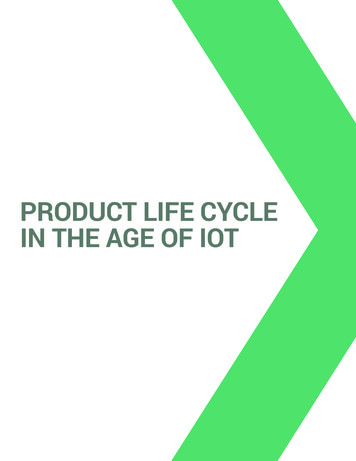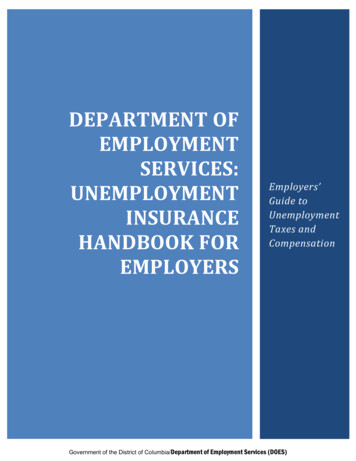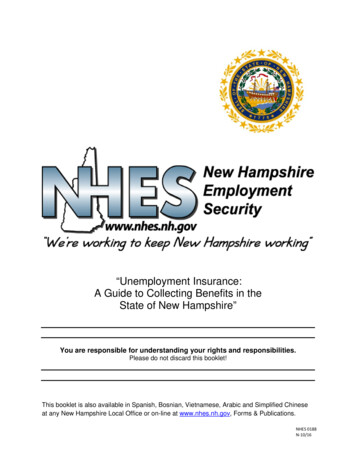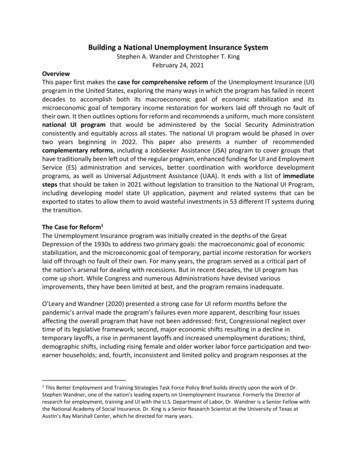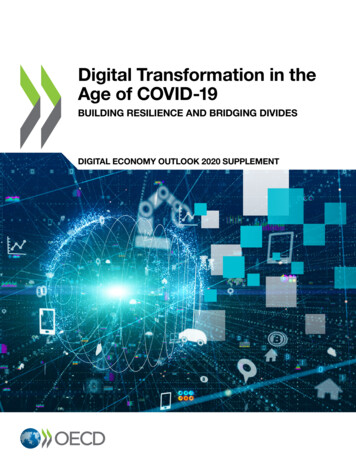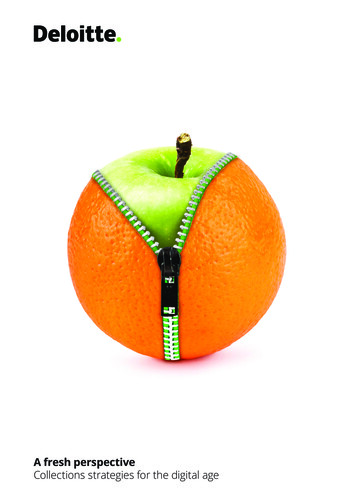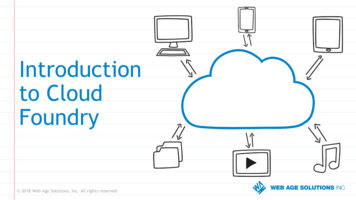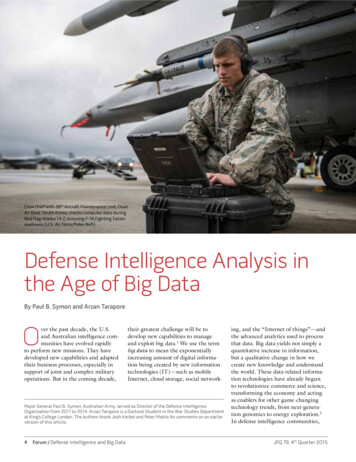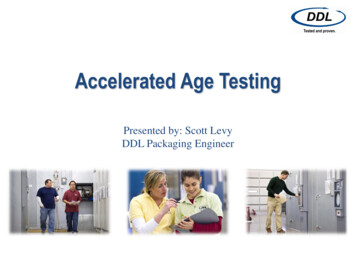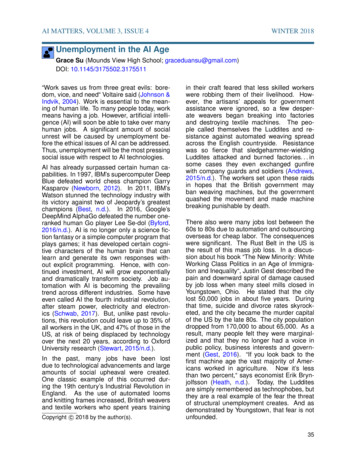
Transcription
AI MATTERS, VOLUME 3, ISSUE 4WINTER 2018Unemployment in the AI AgeGrace Su (Mounds View High School; graceduansu@gmail.com)DOI: 10.1145/3175502.3175511“Work saves us from three great evils: boredom, vice, and need“ Voltaire said (Johnson &Indvik, 2004). Work is essential to the meaning of human life. To many people today, workmeans having a job. However, artificial intelligence (AI) will soon be able to take over manyhuman jobs. A significant amount of socialunrest will be caused by unemployment before the ethical issues of AI can be addressed.Thus, unemployment will be the most pressingsocial issue with respect to AI technologies.AI has already surpassed certain human capabilities. In 1997, IBM’s supercomputer DeepBlue defeated world chess champion GarryKasparov (Newborn, 2012). In 2011, IBM’sWatson stunned the technology industry withits victory against two of Jeopardy’s greatestchampions (Best, n.d.). In 2016, Google’sDeepMind AlphaGo defeated the number oneranked human Go player Lee Se-dol (Byford,2016/n.d.). AI is no longer only a science fiction fantasy or a simple computer program thatplays games; it has developed certain cognitive characters of the human brain that canlearn and generate its own responses without explicit programming. Hence, with continued investment, AI will grow exponentiallyand dramatically transform society. Job automation with AI is becoming the prevailingtrend across different industries. Some haveeven called AI the fourth industrial revolution,after steam power, electricity and electronics (Schwab, 2017). But, unlike past revolutions, this revolution could leave up to 35% ofall workers in the UK, and 47% of those in theUS, at risk of being displaced by technologyover the next 20 years, according to OxfordUniversity research (Stewart, 2015/n.d.).In the past, many jobs have been lostdue to technological advancements and largeamounts of social upheaval were created.One classic example of this occurred during the 19th century’s Industrial Revolution inEngland. As the use of automated loomsand knitting frames increased, British weaversand textile workers who spent years trainingCopyright c 2018 by the author(s).in their craft feared that less skilled workerswere robbing them of their livelihood. However, the artisans’ appeals for governmentassistance were ignored, so a few desperate weavers began breaking into factoriesand destroying textile machines. The people called themselves the Luddites and resistance against automated weaving spreadacross the English countryside. Resistancewas so fierce that sledgehammer-wieldingLuddites attacked and burned factories. . . insome cases they even exchanged gunfirewith company guards and soldiers (Andrews,2015/n.d.). The workers set upon these raidsin hopes that the British government mayban weaving machines, but the governmentquashed the movement and made machinebreaking punishable by death.There also were many jobs lost between the60s to 80s due to automation and outsourcingoverseas for cheap labor. The consequenceswere significant. The Rust Belt in the US isthe result of this mass job loss. In a discussion about his book “The New Minority: WhiteWorking Class Politics in an Age of Immigration and Inequality“, Justin Gest described thepain and downward spiral of damage causedby job loss when many steel mills closed inYoungstown, Ohio. He stated that the citylost 50,000 jobs in about five years. Duringthat time, suicide and divorce rates skyrocketed, and the city became the murder capitalof the US by the late 80s. The city populationdropped from 170,000 to about 65,000. As aresult, many people felt they were marginalized and that they no longer had a voice inpublic policy, business interests and government (Gest, 2016). “If you look back to thefirst machine age the vast majority of Americans worked in agriculture. Now it’s lessthan two percent,“ says economist Erik Brynjolfsson (Heath, n.d.). Today, the Ludditesare simply remembered as technophobes, butthey are a real example of the fear the threatof structural unemployment creates. And asdemonstrated by Youngstown, that fear is notunfounded.35
AI MATTERS, VOLUME 3, ISSUE 4However, Brynjolfsson also states that “Thecomputer processor doubles in power every18 months, 10 times greater every five years,it’s a very different scale of advancement andit’s affecting a broader set of the economy thanthe steam engine did, in terms of all the cognitive tasks. It’s happening a lot faster andmore pervasively than before” (Heath, n.d.).Because of the swiftness of technology development, AI unemployment is a looming problem that needs to be confronted now.In the near future, AI will cause unemployment as other technology did in the past, anddangerous social unrest will be provoked, perhaps at an even faster pace according to Brynjolfsson: “Unlike much of the 20th centurywe’re now seeing a falling ratio of employment to population and that’s something thatconcerns us. We don’t think it’s inevitablebut we do think that many of the underlyingtrends in technology are likely to acceleratethis so it’s something we need to pay someserious attention to” (Heath, n.d.). Displacedworkers are a political force that cannot beignored, especially in elections. What theywant are well-paid jobs that can support theirfamilies. Government, industries, and organizations should address unemployment issuescaused by AI rather than brushing them offand claiming there will be more jobs createdin the new technology revolution. Politicians inthe past have promised to bring jobs lost dueto outsourcing back to US. However, manytraditional manufacturing jobs will never comeback. According to research, while cheaperlabor could cut cost by 60%, automation couldcut labor costs by 90%. Even China, a countryknown for its abundant cheap labor and manufacturing jobs, has become a country withrising wages and labor shortages (Mahoney,n.d.). In 2017, China surpassed Japan asthe number one country that uses the mostindustrial robots for manufacturing. Job automation is simply a natural choice for developed country to stay competitive in the globaleconomy. With advances in automation andAI technology, some manufacturing factorieswill come back to US to get closer to the mainmarkets. Unfortunately, moving back thesefactories will not create traditional manufacturing jobs; it will create more automated jobsinstead. If unemployment continues, the income gap between the richest and the poorestWINTER 2018people will get even wider. Income inequalitywill increase as owners of AI capital will expand their wealth while many workers may notreceive benefits. Additionally, the wage gapbetween skilled and unskilled workers will increase. Long term unemployment cannot berisked as less income for families means lowconsumer demand that reduces income forbusinesses in other markets, gradually leading to a vicious cycle of economic downturn.A loss of dignity for workers may also accompany the unemployment AI will cause. Socialunrest, crime, homicide, riots, race tension,and other current social problems could be exacerbated. However, the root cause of theseproblems can often be attributed to unemployment and lack of career opportunities. AI hasthe potential to cause many economic and social issues by automating many jobs and leaving millions of workers unemployed.Companies have already begun to develop AItechnology that will become the new engineof the old and continued process of job automation. Many countries have already usedbasic automation technology to replace labor.For example, industrial robots are widely usedin automobile production lines across NorthAmerica, Europe, Japan, South Korea, etc.However, with AI, job automation will be accelerated and it will have a broader impact. Thatis because traditional automation involves explicit programming, which requires a lot of human labor, and consequently increases production costs. In contrast, AI can utilize machine learning without explicit programmingby evolving itself with the empirical data itcollects from experimentation. For instance,Google’s AI, AlphaGo, played Go against itself millions of times before competing with thebest human player (Byford, 2016/n.d.). AI’scapabilities can be improved dramatically andswiftly through repetitive training and aroundthe-clock experimentation through trial and error. Such a powerful learning system can beeasily applied in many areas of life. One example of today’s usage of machine-learningAI is the self-driving car (Giarratana, 2016).It would be extremely difficult and inefficientto develop self-driving technology through atraditional explicit programming method. Itwould require software engineers to accountfor all possible scenarios that could happenduring real-life driving. Such conditions are36
AI MATTERS, VOLUME 3, ISSUE 4unlimited and are impossible to cover completely. But with AI technology, the car’s system could make decisions that mimic a humandriver’s and learn from driving data sharedfrom other self-driving cars. Google, Tesla,Uber, Ford, GM, BMW and most major automobile manufacturers are developing selfdriving technologies. Many of them have already conducted hundreds of thousands ofmiles of real road testing. Such technology in certain aspects has surpassed humandrivers because they have long-range radar,LIDAR, cameras, short/medium-range radar,ultrasound, and GPS, giving self-driving carsa multitude of senses that are superior to ahuman’s (Giarratana, 2016). Self-driving carscan also communicate with each other wirelessly to know each other’s driving intentions,make decisions and reactions much fasterthan a human, and do not get distracted ortired like a human. Therefore, self-driving carsare safer and could significantly diminish traffic fatalities. In fact, self-driving cars couldproduce a crash rate reduction of up to 90percent (Ramsey, 2015). It is certain in thenear future that many drivers’ jobs will eventually be replaced by self-driving AI technology.However, today’s progress in developing selfdriving cars also demonstrates that AI has thepotential to be ready to take over many otherjobs very soon.Even just a big loss of driving jobs will create a large impact on society. An estimatedfive million professional drivers’ jobs, includingtruck drivers, taxi drivers, school bus drivers,and transit bus drivers, could be lost to selfdriving technology (Greenhouse, 2016; Fahey, 2016). These drivers usually do not havehigher education or other skills to find better replacement jobs. Their possible alternative jobs are limited and shrinking as the barfor education and skills to enter the future jobmarket rises. Many families rely on the driveras the main income provider of the family. If3/5 of the 5 million drivers have a family offour people, it would amount to about 12 million people’s lives being affected by unemployment. Permanent displacement of thesedrivers would have devastating effects on families and their children. This negative impacton drivers’ lives could ripple through multiplegenerations without external help. Additionally, many jobs areas supporting drivers suchWINTER 2018as driving schools, gas stations, and car dealerships may also disappear. For instance,lower accident rates would lead to less frequent visits to auto body repair shops, andthat would leave a significant portion of the445,000 auto body repairers in the US withouta job (Lee, 2015). If losing jobs in one sector can cause this much damage, then societymust prepare itself carefully for the unemployment AI could create.Besides driving jobs, a variety of other laborpositions could be replaced by AI automation. According to McKinsey & Company, fivefactors determine if a job can be automated:technical feasibility, cost to automate, relative scarcity, skills required, and cost of workers (Chui, Manyika, & Miremadi, 2015/n.d.).There are a wide range of job areas that aresubject to AI takeover, such as transportationand logistics, office and administrative support, personal and domestic service, accounting, and construction (Rotman, 2013). Production lines that manufacture large quantitiesof fixed design are also candidates becausethey usually contain jobs that are repetitive.Many of these jobs are already automated orin the process being automated with consideration of the 5 factors mentioned above. Additionally, AI technology in image and soundrecognition has surpassed humans, so manysecurity jobs will be replaced by AI. Also,there are already robots that can flip burgers. Food preparation could be replaced byAI that is capable of controlling multiple factors precisely, including temperature, cookingtime, color, smell and taste. In construction,there are already bricklayer robots that are inuse. A company called Apis Cor used a 3Dprinting robot and built a house in Moscow in24 hours (Cor, 2017). The house can last upto 175 years and costs only 10,134 to build.With AI technology, a machine may be ableto understand a building plan without requiringa human programmer to program the buildingplan into the system. Warehouse workers canbe replaced by AI robots that know the precise location of stocked goods and executesorders tirelessly and efficiently. In farming,AI technology could also help farmer detectplant diseases earlier to take preventive actions. It is possible that AI will become a powerful general-purpose tool that is used everyday for work and study like today’s personal37
AI MATTERS, VOLUME 3, ISSUE 4computers and smart-phones. Therefore, inlow or medium skilled labor, AI automation willpush wages lower than ever, making the lesseducated work force even poorer.Unlike previous industrial revolutions, AI couldautomate a multitude of jobs throughout theoccupation spectrum, including intellectualjobs. But, there are not enough jobs that couldquickly absorb displaced workers without extensive retraining. Breakthroughs in AI-basedvoice recognition have made automated voicesearch and personal assistants practical touse. Siri, Cortana, Alexa and Google Noware current examples of such systems. Whenthese technologies mature, jobs such as personal assistances and foreign language translators will be eventually replaced by AI. Traditional high-paying jobs such as Wall Streettraders could also lose their jobs. For example, Goldman Sachs used AI to replace600 traders and left only two traders remaining, who were supported with 200 computerengineers (Byrnes, 2017). IBM’s Watson AIsystem has already replaced 34 workers in aJapanese insurance company called FukokuMutual Life Insurance to calculate payouts topolicyholders. The system is based on IBM’sWatson Explorer, which possesses cognitivetechnology that can think like a human, enabling it to analyze and interpret all of yourdata, including unstructured text, images, audio and video according to the company (Asia,2017). While IBM’s Watson system has moreknowledge than most humans, even its abilities to use knowledge is no match for a human’s yet; however, it is powerful enough toautomate a lot intellectual work to help human to make decisions. Some routine datacollection and processing jobs such as legalassistant and accounting clerk are also subject to replacement by AI. Many other traditional white-collar jobs such as financial advisor, bank teller, and insurance underwritercould be largely automated or replaced byAI. As a result, it is not just the low wage,less educated work force, that will be affected,as many careers that require higher education could also be eliminated. According to2013 government statistics, the US has 36 million (27.2% employment share) jobs that require less than high school diploma, and 51million (39% employment share) that requirea high school diploma (Williams-Grut, 2016).WINTER 2018In total, 87 million (66% employment share)jobs require a high school education level orhigher, making it difficult for workers to climbup the employment ladder even if AI does create new job opportunities while replacing traditional jobs. In conclusion, the impact of AIcaused unemployment should not be underestimated.To confront this issue and reduce unemployment caused by AI, it is largely a matter oflooking at the issue economically and adjusting the supply and demand of labor so thatemployment levels will have room to grow. Demand for labor comes from employers andis derived from consumer demand for goods.Supply for labor comes from how many workers are willing and able to work in the job market. Jobs that can be replaced by AI will havetheir demand of labor lowered due to improvements in capital, causing unemployment. Organizations and governments could find waysto increase demand of labor in other job areas to prevent structural unemployment frombecoming permanent. On the demand side,common economic policies to raise employment includes injecting more money into theeconomy to increase consumer demand andtherefore labor demand, giving governmentsubsidies to companies that hire the long-termunemployed, and lowering employment taxes.On the supply side, employment can be raisedthrough increasing investment in human capital to lessen occupational immobility and decreasing housing costs to reduce geographical immobility (Pettinger, 2017). These common policies and similar ones can be implemented by governments, industries, and organizations to prepare for the new wave ofunemployment AI will create. Organizationscan also discuss how to encourage the economy to allow job automation to lead to moreprofit, consumer demand, and therefore labor demand, instead of letting AI cut worktoo drastically. The funds for these methodscan be raised through private sector contributions, taxes, or donations. These standardeconomic policies’ applications, if consideredwithin the specific context of the AI industry,will then help prevent AI-induced unemployment.Governments, industries, and organizationscan furthermore discuss plans to expand newcareers that will be created by AI to minimize38
AI MATTERS, VOLUME 3, ISSUE 4the impact of mass unemployment. For example, with more AI used in our society, therewill be more demand for AI jobs and trainersof all kinds. AI safety engineers, maintenanceengineers, machine designers, and ethics researchers are some examples of possible newjobs. Specialized skills such as data analysiswill be needed to identify areas that can usedata to train AI and prepare data to conductthe training. As more and more opportunities for AI applications appear, new jobs thatare difficult to predict today will also be created. Humans will be able to focus on doingmore rewarding work such as scientific discovery, problem solving, and innovative design. Jobs indirectly related to AI will also expand, such as educational content creation forpeople who will go into AI careers. Expertsin careers that will benefit from AI technologywill also be in demand as AI implementationneeds deep knowledge of each field for successful specialization. For instance, a field ascomplicated as neuroscience will require experts to create a usable AI system, becauseAI systems are only as good as the peoplewho design them. The decline of monotonousjobs will also allow for creative jobs to expand as people have more time to pursue lesstechnical interests. However, Moravec’s paradox predicts that manual jobs are sometimesmore resilient to job loss than middle-skilledjobs (Heath, n.d.). As a result, job expansionmay occur in low and high skilled jobs, butnot in middle skilled jobs. Society must investmore in higher education to adjust to this newset of jobs.9.5 million job openings are predicted to begenerated by AI; however, most of these areonly open to the well-educated (Williams-Grut,2016). To solve the unemployment problem,education that teaches skills for AI professions will be the key. Similar to how in the1950s, funding of secondary learning helpedcurtail the unemployment effects of the Industrial Revolution, funding of college-level lear
higher education or other skills to find bet-ter replacement jobs. Their possible alterna-tive jobs are limited and shrinking as the bar for education and skills to enter the future job market rises. Many families rely on the driver as
